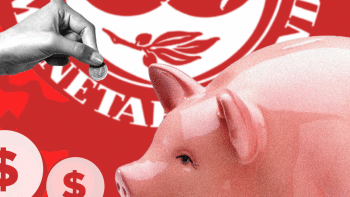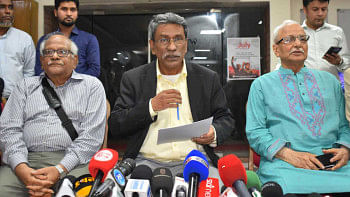Will the IMF loan stop forex reserve depletion?

The USD 4.5 billion loan from the International Monetary Fund (IMF) may not be an effective remedy for the current trend of depletion in Bangladesh's foreign exchange reserves – which has dwindled to USD 26 billion from USD 40 billion. This trend should be alarming enough to wake up policymakers to redesign strategies to prevent a full-scale crisis from happening. First, the finance ministry must give up its stubbornness in four areas: i) the non-market lending-rate cap at nine percent; ii) the non-market peanut-type remittance incentives of 2.5 percent; iii) the non-market 10-plus percent of savings rates on sanchayapatra (savings certificates); and iv) managed non-market exchange rates. The word "non-market" in all of them explains why they should go.
Anyone reading this article would think that I have wrongfully assigned the responsibilities to the finance ministry while all of them belong to the central bank. But an outsider wouldn't have any clue as to how the omnipotent, all-encompassing hegemony of the finance ministry has turned Bangladesh's central bank into an obliged, domesticated institution. The IMF team has advised the Bangladesh Bank to act independently to restore macro-stability by lowering inflation and reducing current account deficits.
If the Bangladesh Bank, with all its expertise and research findings, can't work courageously, the IMF loan will be a waste of opportunity and the reserve depletion will not slow down. We can't forget that India faced its worst financial disaster in 1991 when the country's reserves hit its import footing equivalent to less than a month. With USD 26 billion of forex reserves, Bangladesh Bank can now foot import bills of 3.5 months or so – which came down from six months' footing just a year ago. Reserves are like food for the economy, and its alarming depletion is a signal of an impending crisis.
The IMF team has also highlighted four areas where the government should bring about market-based changes: i) the lending-rate cap should be removed to make the monetary policy work and to put a brake on credit growth as well as inflation; ii) the 2.5 percent remittance incentive should be removed as it's a distortion of the market-based exchange rate; iii) sanchayapatra high rates should be brought down as they are distortive to bond markets and are avenues towards unethical arbitrage by money lords; and iv) the spectrum of various exchange rates being distortive to the market should be unified to reflect the market rate. The sooner the government delivers these tasks to the Bangladesh Bank, the quicker the reserve depletion can be prevented from getting worse.
The IMF loan is to be exhausted in seven instalments by 2026. Thus, it's nothing in comparison to the country's monthly demand for import financing, which is USD 7-8 billion. It's equivalent to the remittance income for less than three months. Its interest rate will be around 2.2 percent, which will effectively be a negative real interest rate of 2.5 percent given the global inflation of four to five percent over the next three years. Moreover, the loose grace periods seem to be over-accommodating for a country like Bangladesh, whose growth performance is respectable at six to seven percent. But the main point of the IMF loan is its conditionalities, which are more important than the physical amount of the loan.
The loan allows the IMF to put a brake on government policymakers who, in recent years, have been inventing neo-economic theories of their own , defying any lessons of typical macroeconomic textbooks. The IMF wants the policymakers to be adaptive to changes in the global arena, where all central banks have raised policy rates. The Bangladesh Bank has also raised the repo rate, but it is perfunctory and ineffective in the face of having the lending-rate cap at nine percent.
The prime minister advised to do so three years ago to help the small and medium enterprises, which can boost investment. But the real beneficiaries are the big tycoons and defaulters of this cap. The relevance of the cap has been redundant in the face of the new reality of high inflation across the globe. When inflation has reached almost double-digit, the nine percent lending rate will give a negative real interest rate to the banks, because the real interest rate is the nominal rate minus inflation, as per the Fisher Equation.

The rate of reserve depletion is alarming, and the IMF loan will not be enough to fend off the haemorrhage. But the conditionalities attached to the loan, if properly implemented, will be good enough to reverse the trend of current account deficit – and thus the atrophy of reserves. The two vital forces that can defend the decay are exports and remittances. If the exchange rate is determined based on the market, both components will gain momentum. And a high dollar value, say at Tk 112-115, will dampen the roaring rise in imports. That type of exchange rate doesn't need a distortive fiscal burden of the 2.5 percent incentive in remittance.
If the IMF loan forces the government to increase the fiscal space and raise the amount of revenue, that will help lower sanchayapatra rates and thus the interest burden on the budget. The government must devise a mechanism by which widows, poor women, poor pensioners, farmers, and the vulnerable get preferential rates – higher than the market. Currently, the super-rich are exploiting the sanchayapatra, which was originally designed to help the disadvantaged. If this moral hazard can be fought out, people will find investment more attractive than idle savings. All these tasks belong to the central bank, which must be allowed to act independently.
Dr Birupaksha Paul is a professor of economics at the State University of New York at Cortland in the US, and former chief economist at Bangladesh Bank.

 For all latest news, follow The Daily Star's Google News channel.
For all latest news, follow The Daily Star's Google News channel. 










Comments